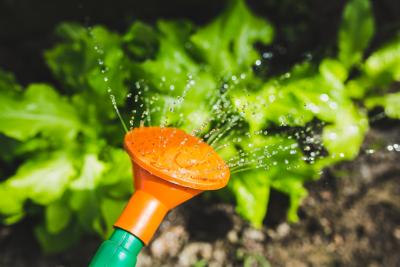Smart Irrigation
When do plants need watered most?
Daylight length, temperature, and wind drive plant water needs.
Plants usually need more water in the spring than in other times of the year, but keep in mind that overwatering can be just as bad for lawns or plants as drought. In general, if you want green grass in the summer, water deeply but infrequently, about an inch a week, in the early morning.
Remember, you only need to apply enough irrigation to replace soil moisture lost through evaporation and through the life cycle of your plants. Combined, this is called Evapotranspiration, or ET. ET varies based on day length, temperature, amount of incoming sunlight, wind speed, humidity, and time of year (plants need different amounts of water in different stages of their growing cycle). Consider wet weather in the forecast as you plan your irrigation session.
Spring is a great time to tune up your irrigation system, but if you didn't get around to it, summer is also a good time for it. Fix broken heads, and make sure heads are aimed so they irrigate your landscape and not sidewalks, driveways, or your home's exterior. Calculate your system's application rate so you will know how long it takes to run your system to apply only as much water as your plants need.
In general, for green grass in the summer, water in the early morning and only apply about 1 inch per week.
How many minutes should you run your sprinkler or irrigation system?
That depends on your system. First, find the application rate by spreading some inch-deep cans or containers all around the irrigated area. Tuna cans, cat or dog food cans, or other straight-sided containers will work. Rain gauges work really well, too. Run your sprinkler or irrigation system until the inch-deep, straight-sided container is full. Note how long it took to fill up - this is the amount of time it takes per inch. You can then figure out how many inches per hour or inches per minute your system applies.
For example, if it took 30 minutes to fill the inch deep container, your system applies two inches per hour.
Remember, during the summer you probably only need about 1 inch per week. If you have heavy soil (e.g., clay) or are watering with a hose-end sprinkler, irrigating only ONE DAY per week is okay. Watering fewer days per week can encourage deeper root growth and reduce the irrigation you need to provide, but please irrigate in two or three shorter CYCLES to allow water to infiltrate rather than run off.
However, if you have an automatic irrigation system and very well-drained soil, splitting your weekly irrigation into two or three irrigation days may make sense to prevent moisture stress in your plants. These frequent waterings will not encourage deep root growth but can also lead to excess weed germination as the soil surface is wet more often.
To save more water, you can also consider installing more efficient irrigation systems, such as drip systems and smart irrigation controls.
Want to make your irrigation season easy this summer?
Consider letting your lawn go dormant. Irrigate just once or twice during the growing season. Your lawn will turn a golden color as the turf goes into dormancy. If you have an Eco-Lawn, the other species (clover, yarrow, etc.) may still provide a nice green area for you to use as a lawn with less water and less mowing. See A Golden Landscape for details.
See below for more resources:
Practical Lawn Care for Western Oregon by OSU extension - this is a great resource for learning how much you need to water to achieve the type of lawn you want!
Watering Efficiently Outside by Regional Water Providers Consortium
Lawns by Regional Water Providers Consortium
